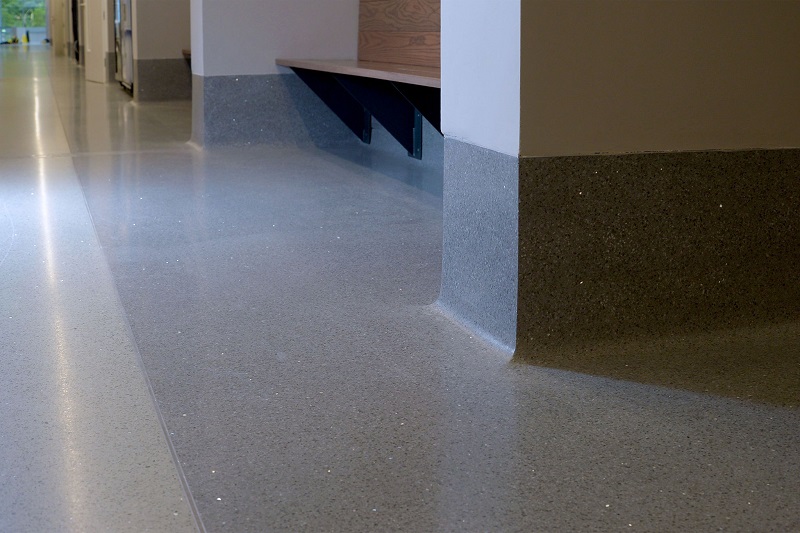Resin flooring
Resin flooring produces a hard-wearing 'plastic' surface. Its highly durable finish means that it is a popular design choice for heavy-use environments such as pharmaceutical, chemical, storage and logistics areas, commercial and public areas.
Typically, resin floors comprise a primer which penetrates and reacts with a substrate layer (usually concrete), creating a high-strength bond. A body coat of resin is then applied on top of the primer, and this creates the bulk of the floor thickness, the decorative finish and key performance characteristics such as impact resistance. Typically, 1-3 seal coats will then be used to encapsulate the body coat and provide additional performance characteristics, such as resistance to chemicals and wear.
The main types of resin used are:
- Epoxy.
- Methyl methacrylate (MMA).
- Polyurethane (PU).
Other ingredients can be added, such as; aggregates, decorative chips/flakes, pigments, cement powder, specific chemical resistance additives and so on. This may increase the thickness of the body coat.
As well as being tougher in compression than concrete, resin flooring can have some stress flexibility, which makes it durable under impact and thermal shock. In addition to its greater compressive strength, resin can dissipate loading and increase the base concrete’s weight-bearing limit.
Other advantages of resin flooring include:
- Ease of maintenance.
- An impervious barrier is created enabling the flooring to be easily cleaned and meaning they don’t harbour bacteria.
- Slip-resistant versions can be created by adding graded aggregates within the base layer, creating safer environments.
- Design flexibility is possible due to a huge range of available finishes.
- There do not need to be joints in the surface layer.
[edit] Related articles on Designing Buildings Wiki
Featured articles and news
The Building Safety Forum at the Installershow 2025
With speakers confirmed for 24 June as part of Building Safety Week.
The UK’s largest air pollution campaign.
Future Homes Standard, now includes solar, but what else?
Will the new standard, due to in the Autumn, go far enough in terms of performance ?
BSRIA Briefing: Cleaner Air, Better tomorrow
A look back at issues relating to inside and outside air quality, discussed during the BSRIA briefing in 2023.
Restoring Abbotsford's hothouse
Bringing the writer Walter Scott's garden to life.
Reflections on the spending review with CIAT.
Retired firefighter cycles world to raise Grenfell funds
Leaving on 14 June 2025 Stephen will raise money for youth and schools through the Grenfell Foundation.
Key points for construction at a glance with industry reactions.
Functionality, visibility and sustainability
The simpler approach to specification.
Architects, architecture, buildings, and inspiration in film
The close ties between makers and the movies, with our long list of suggested viewing.
SELECT three-point plan for action issued to MSPs
Call for Scottish regulation, green skills and recognition of electrotechnical industry as part of a manifesto for Scottish Parliamentary elections.
UCEM becomes the University of the Built Environment
Major milestone in its 106-year history, follows recent merger with London School of Architecture (LSE).
Professional practical experience for Architects in training
The long process to transform the nature of education and professional practical experience in the Architecture profession following recent reports.
A people-first approach to retrofit
Moving away from the destructive paradigm of fabric-first.
International Electrician Day, 10 June 2025
Celebrating the role of electrical engineers from André-Marie Amperè, today and for the future.
New guide for clients launched at Houses of Parliament
'There has never been a more important time for clients to step up and ...ask the right questions'
The impact of recycled slate tiles
Innovation across the decades.
EPC changes for existing buildings
Changes and their context as the new RdSAP methodology comes into use from 15 June.

























